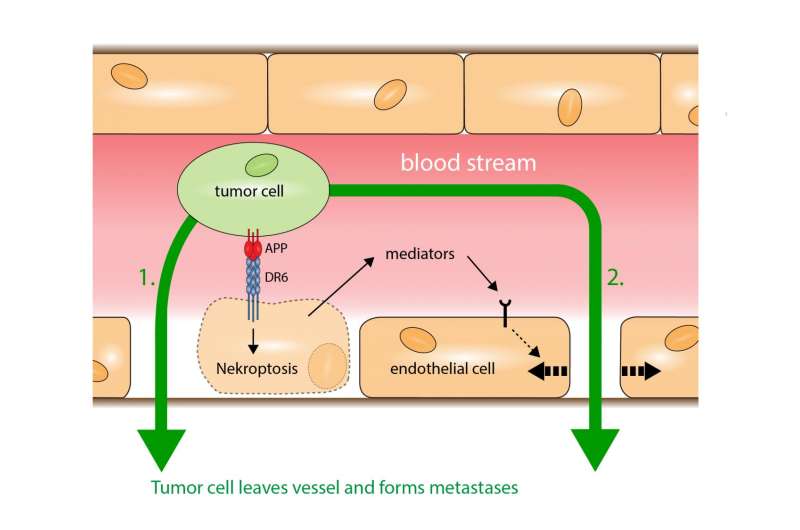Loophole for cancer cells

Many cancers only become a mortal danger if they form metastases elsewhere in the body. Such secondary tumours are formed when individual cells break away from the main tumour and travel through the bloodstream to distant areas of the body. To do so, they have to pass through the walls of small blood vessels. Scientists from the Max Planck Institute for Heart and Lung Research in Bad Nauheim and Goethe University Frankfurt have now shown that tumour cells kill specific cells in the vascular wall. This enables them to leave the vessels and establish metastases, a process facilitated by a molecule called DR6.
The most common cause of cancer deaths is not the primary tumour itself but metastases that subsequently form. Most tumour cells spread via the bloodstream. To do so, individual tumour cells have to enter blood vessels and leave the bloodstream again at remote locations.
Together with scientists at the universities of Cologne and Heidelberg, the Research Group led by Stefan Offermanns, Director of the Department of Pharmacology at the Max Planck Institute for Heart and Lung Research and professor at Goethe University Frankfurt, has now succeeded in clarifying the underlying mechanism. The researchers, working with cell cultures, first observed how individual tumour cells kill specific cells in the vascular wall, called endothelial cells. This process, known as necroptosis, enabled cancer cells to overcome an endothelial cell layer in the laboratory. "We were then able to show in studies on mice that the same process occurs in living organisms," says Boris Strilic, first author of the study.
The scientists also found that endothelial cells themselves give the signal for their own death: To do this, the vascular wall cells have a receptor molecule called Death Receptor 6 (DR6) on their surface. "When a cancer cell comes into contact with it, a protein on the cell's surface, known as APP, activates DR6. This marks the start of the cancer cells' attack on the vascular wall, which culminates in the necroptosis of wall cells," Strilic explains.
Death Receptor in the cell membrane
The Max Planck researchers then showed that less necroptosis of endothelial cells and less metastasis occur in genetically modified animals in which Death Receptor 6 is disabled. "This effect was also found after a blockade of DR6 or the cancer-cell protein APP, thus confirming our previous observations," Strilic says.
It is still not entirely clear whether the cancer cells migrate directly through the resulting gap in the vascular wall or whether there is an indirect effect: "We have evidence that many more molecules are released when the vascular wall cell dies and that they render the surrounding area more permeable to cancer cells," says Offermanns.
"This mechanism could be a promising starting point for treatments to prevent the formation of metastases," says Offermanns. First, however, it must be determined whether a blockade of DR6 triggers unwanted side effects. It must also be determined to what extent the observations can be transferred to humans.
More information: Boris Strilic et al, Tumour-cell-induced endothelial cell necroptosis via death receptor 6 promotes metastasis, Nature (2016). DOI: 10.1038/nature19076



















